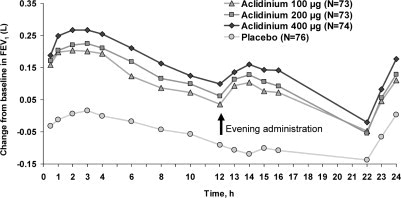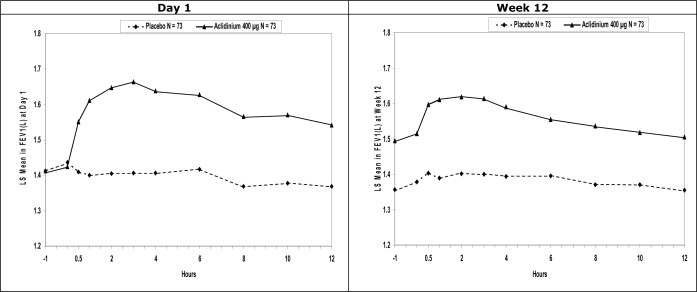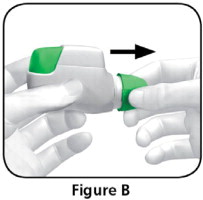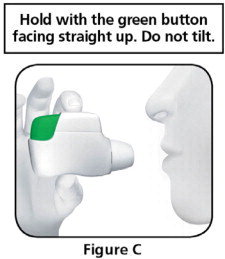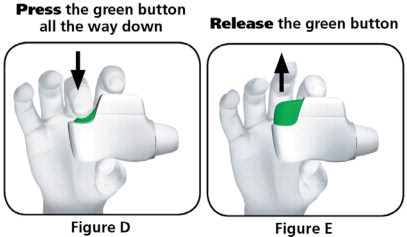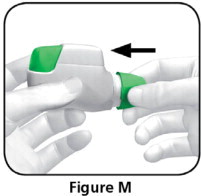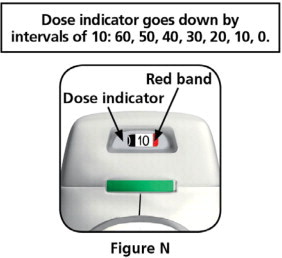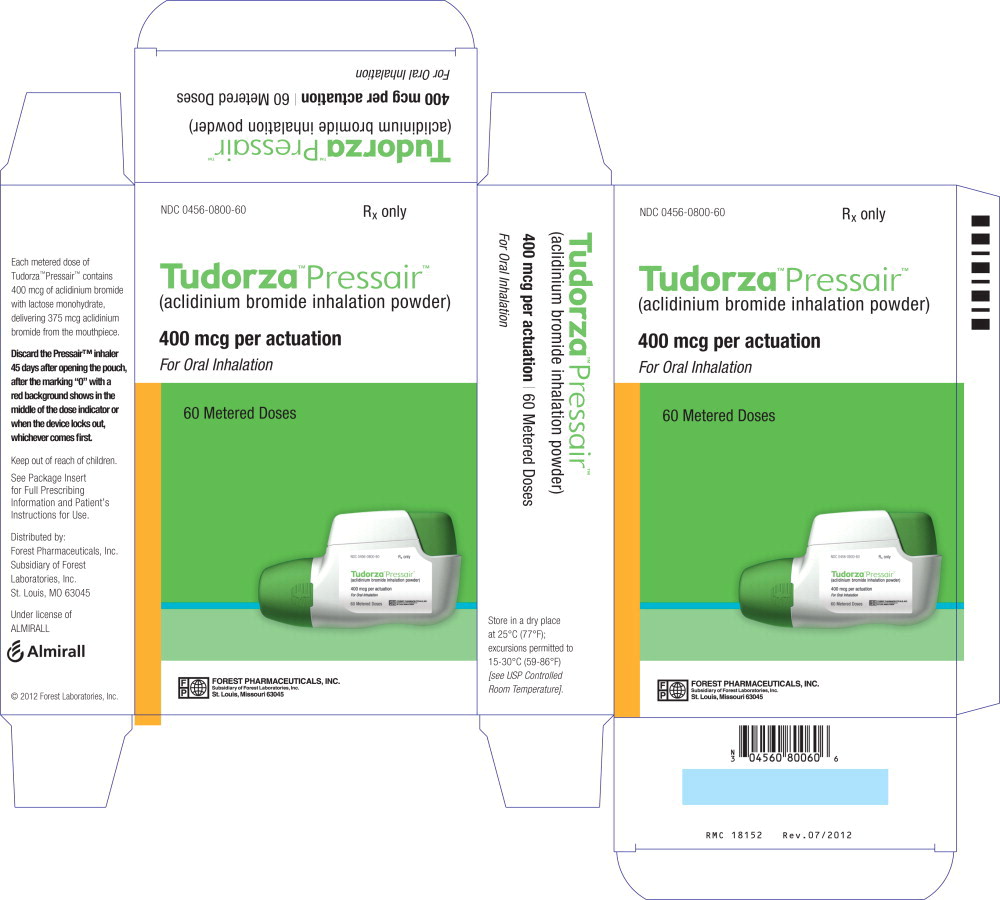TUDORZA PRESSAIR- aclidinium bromide inhalant
ALLERGAN, INC.
----------
HIGHLIGHTS OF PRESCRIBING INFORMATIONThese highlights do not include all the information needed to use TUDORZA PRESSAIR safely and effectively. See full prescribing information for TUDORZA PRESSAIR.
TUDORZA® PRESSAIR® (aclidinium bromide inhalation powder) FOR ORAL INHALATION ONLY Initial U.S. Approval: 2012 RECENT MAJOR CHANGESWarnings and Precautions (5.5) 04/2015 INDICATIONS AND USAGETUDORZA PRESSAIR is an anticholinergic indicated for the long-term maintenance treatment of bronchospasm associated with chronic obstructive pulmonary disease (COPD), including chronic bronchitis and emphysema. (1) DOSAGE AND ADMINISTRATIONFor oral inhalation only
DOSAGE FORMS AND STRENGTHS
CONTRAINDICATIONSNone. (4) WARNINGS AND PRECAUTIONS
ADVERSE REACTIONSMost common adverse reactions (≥3% incidence and greater than placebo) are headache, nasopharyngitis and cough. (6.1) To report SUSPECTED ADVERSE REACTIONS, Contact Forest Laboratories, LLC. at 1-800-678-1605 or FDA at 1-800-FDA-1088 orwww.fda.gov/medwatch. DRUG INTERACTIONSAnticholinergics: May interact additively with concomitantly used anticholinergic medications. Avoid administrations of TUDORZA PRESSAIR with other anticholinergic-containing drugs. (7.2) See 17 for PATIENT COUNSELING INFORMATION and FDA-approved patient labeling. Revised: 4/2015 |
FULL PRESCRIBING INFORMATION
1 INDICATIONS AND USAGE
TUDORZA® PRESSAIR® (aclidinium bromide inhalation powder) is indicated for the long-term, maintenance treatment of bronchospasm associated with chronic obstructive pulmonary disease (COPD), including chronic bronchitis and emphysema.
2 DOSAGE AND ADMINISTRATION
The recommended dose of TUDORZA PRESSAIR is one oral inhalation of 400 mcg, twice daily.
3 DOSAGE FORMS AND STRENGTHS
Inhalation Powder. TUDORZA PRESSAIR is a breath-actuated multi-dose dry powder inhaler metering 400 mcg of aclidinium bromide per actuation.
5 WARNINGS AND PRECAUTIONS
5.1 Not for Acute Use
TUDORZA PRESSAIR is intended as a twice-daily maintenance treatment for COPD and is not indicated for the initial treatment of acute episodes of bronchospasm (i.e., rescue therapy).
5.2 Paradoxical Bronchospasm
Inhaled medicines, including TUDORZA PRESSAIR, may cause paradoxical bronchospasm. If this occurs, treatment with TUDORZA PRESSAIR should be stopped and other treatments considered.
5.3 Worsening of Narrow-Angle Glaucoma
TUDORZA PRESSAIR should be used with caution in patients with narrow-angle glaucoma. Prescribers and patients should be alert for signs and symptoms of acute narrow-angle glaucoma (e.g., eye pain or discomfort, blurred vision, visual halos or colored images in association with red eyes from conjunctival congestion and corneal edema). Instruct patients to consult a physician immediately should any of these signs or symptoms develop.
5.4 Worsening of Urinary Retention
TUDORZA PRESSAIR should be used with caution in patients with urinary retention. Prescribers and patients should be alert for signs and symptoms of prostatic hyperplasia or bladder-neck obstruction (e.g., difficulty passing urine, painful urination). Instruct patients to consult a physician immediately should any of these signs or symptoms develop.
5.5 Immediate Hypersensitivity Reactions
Immediate hypersensitivity reactions, including anaphylaxis, angioedema (including swelling of the lips, tongue, or throat), urticaria, rash, bronchospasm, or itching, have occurred after administration of TUDORZA PRESSAIR. If such a reaction occurs, therapy with TUDORZA PRESSAIR should be stopped at once and alternative treatments should be considered. Given the similar structural formula of atropine to aclidinium, patients with a history of hypersensitivity reactions to atropine should be closely monitored for similar hypersensitivity reactions to TUDORZA PRESSAIR. In addition, TUDORZA PRESSAIR should be used with caution in patients with severe hypersensitivity to milk proteins.
6 ADVERSE REACTIONS
The following adverse reactions are described in greater detail in other sections:
- Paradoxical bronchospasm [see Warnings and Precautions (5.2)]
- Worsening of narrow-angle glaucoma [see Warnings and Precautions (5.3)]
- Worsening of urinary retention [see Warnings and Precautions (5.4)]
- Immediate Hypersensitivity Reactions [see Warnings and Precautions (5.5)]
6.1 Clinical Trials Experience
Because clinical trials are conducted under widely varying conditions, adverse reaction rates observed in the clinical trials of a drug cannot be directly compared to rates in the clinical trials of another drug and may not reflect the rates observed in practice.
3-Month and 6-Month Trials
TUDORZA PRESSAIR was studied in two 3-month (Trials B and C) and one 6-month (Trial D) placebo-controlled trials in patients with COPD. In these trials, 636 patients were treated with TUDORZA PRESSAIR at the recommended dose of 400 mcg twice daily.
The population had a mean age of 64 years (ranging from 40 to 89 years), with 58% males, 94% Caucasian, and had COPD with a mean pre-bronchodilator forced expiratory volume in one second (FEV1) percent predicted of 48%. Patients with unstable cardiac disease, narrow-angle glaucoma, or symptomatic prostatic hypertrophy or bladder outlet obstruction were excluded from these trials.
Table 1 shows all adverse reactions that occurred with a frequency of greater than or equal to 1% in the TUDORZA PRESSAIR group in the two 3-month and one 6-month placebo-controlled trials where the rates in the TUDORZA PRESSAIR group exceeded placebo.
| Treatment | ||
| Adverse Reactions | TUDORZA PRESSAIR | Placebo |
| Preferred Term | (N=636) | (N=640) |
| n (%) | n (%) | |
| Headache | 42 (6.6) | 32 (5.0) |
| Nasopharyngitis | 35 (5.5) | 25 (3.9) |
| Cough | 19 (3.0) | 14 (2.2) |
| Diarrhea | 17 (2.7) | 9 (1.4) |
| Sinusitis | 11 (1.7) | 5 (0.8) |
| Rhinitis | 10 (1.6) | 8 (1.2) |
| Toothache | 7 (1.1) | 5 (0.8) |
| Fall | 7 (1.1) | 3 (0.5) |
| Vomiting | 7 (1.1) | 3 (0.5) |
In addition, among the adverse reactions observed in the clinical trials with an incidence of less than 1% were diabetes mellitus, dry mouth, 1st degree AV block, osteoarthritis, cardiac failure, and cardio-respiratory arrest.
Long-term Safety Trials
TUDORZA PRESSAIR was studied in three long term safety trials, two double blind and one open label, ranging from 40 to 52 weeks in patients with moderate to severe COPD. Two of these trials were extensions of the 3-month trials, and one was a dedicated long term safety trial. In these trials, 891 patients were treated with TUDORZA PRESSAIR at the recommended dose of 400 mcg twice daily. The demographic and baseline characteristics of the long term safety trials were similar to those of the placebo-controlled trials. The adverse events reported in the long term safety trials were similar to those occurring in the placebo-controlled trials of 3 to 6 months. No new safety findings were reported compared to the placebo controlled trials.
6.2 Postmarketing Experience
The following adverse reactions have been identified during postapproval use of drug TUDORZA PRESSAIR. Because these reactions are reported voluntarily from a population of uncertain size, it is not always possible to reliably estimate their frequency or establish a causal relationship to drug exposure.
In postmarketing experience with TUDORZA PRESSAIR, immediate hypersensitivity reactions, including anaphylaxis, angioedema (including swelling of the lips, tongue, or throat), urticaria, rash, bronchospasm, or itching have been reported.
7 DRUG INTERACTIONS
In vitro studies suggest limited potential for CYP450-related metabolic drug interactions, thus no formal drug interaction studies have been performed with TUDORZA PRESSAIR[see Clinical Pharmacology (12.3)].
7.1 Sympathomimetics, Methylxanthines, Steroids
In clinical studies, concurrent administration of aclidinium bromide and other drugs commonly used in the treatment of COPD including sympathomimetics (short-acting beta2 agonists), methylxanthines, and oral and inhaled steroids showed no increases in adverse drug reactions.
8 USE IN SPECIFIC POPULATIONS
8.1 Pregnancy
Teratogenic effects: Pregnancy Category C: There are no adequate and well controlled studies in pregnant women. Adverse development effects were observed in rats and rabbits exposed to aclidinium bromide. TUDORZA PRESSAIR should be used during pregnancy only if the potential benefit justifies the potential risk to the fetus.
Effects of aclidinium bromide on embryo-fetal development were examined in rats and rabbits. No evidence of structural alterations was observed in rats exposed during the period of organogenesis at approximately 15 times the recommended human daily dose (RHDD) [based on summed AUCs of aclidinium bromide and its metabolites at inhaled doses less than or equal to 5.0 mg/kg/day]. However, decreased pup weights were observed from dams exposed during the lactation period at approximately 5 times the RHDD [based on summed AUCs of aclidinium bromide and its metabolites at inhaled doses greater than or equal to 0.2 mg/kg/day]. Maternal toxicity was also observed at inhaled doses greater than or equal to 0.2 mg/kg/day.
No evidence of structural alterations was observed in Himalayan rabbits exposed during the period of organogenesis at approximately 20 times the RHDD [based on summed AUCs of aclidinium bromide and its metabolites at inhaled doses less than or equal to 3.6 mg/kg/day]. However, increased incidences of additional liver lobes (3-5%), as compared to 0% in the control group, were observed at approximately 1,400 times the RHDD [based on summed AUCs of aclidinium bromide and its metabolites at oral doses greater than or equal to 150 mg/kg/day], and decreased fetal body weights were observed at approximately 2,300 times the RHDD [based on summed AUCs of aclidinium bromide and its metabolites at oral doses greater than or equal to 300 mg/kg/day]. These fetal findings were observed in the presence of maternal toxicity.
8.2 Labor and Delivery
The effect of TUDORZA PRESSAIR on labor and delivery is unknown. TUDORZA PRESSAIR should be used during labor and delivery only if the potential benefit to the patient justifies the potential risk to the fetus.
8.3 Nursing Mothers
Aclidinium bromide is excreted into the milk of lactating female rats, and decreased pup weights were observed. Excretion of aclidinium into human milk is probable. There are no human studies that have investigated the effects of TUDORZA PRESSAIR on breast-fed infants. Caution should be exercised when TUDORZA PRESSAIR is administered to nursing women.
8.4 Pediatric Use
TUDORZA PRESSAIR is approved for use in the maintenance treatment of bronchospasm associated with COPD. COPD does not normally occur in children. The safety and effectiveness of TUDORZA PRESSAIR in pediatric patients have not been established.
8.5 Geriatric Use
Of the 636 COPD patients exposed to TUDORZA PRESSAIR 400 mcg twice daily for up to 24 weeks in three placebo-controlled clinical trials, 197 were less than 60 years, 272 were greater than or equal to 60 to less than 70 years, and 167 were greater than or equal to 70 years of age. No overall differences in safety or effectiveness were observed between these subjects and younger subjects. Other reported clinical experience has not identified differences in responses between the elderly and younger patients, but greater sensitivity of some older individuals cannot be ruled out. Based on available data for TUDORZA PRESSAIR, no adjustment of dosage in geriatric patients is warranted[see Clinical Pharmacology (12.3)].
8.6 Renal Impairment
The pharmacokinetics of TUDORZA PRESSAIR were investigated in subjects with normal renal function and in subjects with mild, moderate and severe renal impairment[see Clinical Pharmacology (12.3)]. No clinically significant differences in aclidinium pharmacokinetics were noted between these populations. Based on available data for TUDORZA PRESSAIR, no adjustment of dosage in renally impaired subjects is warranted.
8.7 Hepatic Impairment
The effects of hepatic impairment on the pharmacokinetics of TUDORZA PRESSAIR were not studied [see Clinical Pharmacology (12.3)].
11 DESCRIPTION
TUDORZA PRESSAIR consists of a dry powder formulation of aclidinium bromide for oral inhalation only.
Aclidinium bromide, the active component of TUDORZA PRESSAIR is an anticholinergic with specificity for muscarinic receptors. Aclidinium bromide is a synthetic, quaternary ammonium compound, chemically described as 1-Azoniabicyclo[2.2.2]octane, 3-[(hydroxydi-2-thienylacetyl)oxy]-1-(3-phenoxypropyl)-, bromide, (3R)-. The structural formula is:
Aclidinium bromide is a white powder with a molecular formula of C26H30NO4S2Br and a molecular mass of 564.56. It is very slightly soluble in water and ethanol and sparingly soluble in methanol.
TUDORZA PRESSAIR is a breath-actuated multi-dose dry powder inhaler. Each actuation of TUDORZA PRESSAIR provides a metered dose of 13 mg of the formulation which contains lactose monohydrate (which may contain milk proteins) as the carrier and 400 mcg of aclidinium bromide. This results in delivery of 375 mcg aclidinium bromide from the mouthpiece, based onin vitro testing at an average flow rate of 63 L/min with constant volume of 2 L. The amount of drug delivered to the lungs will vary depending on patient factors such as inspiratory flow rate and inspiratory time. The PRESSAIR inhaler delivers the target dose at flow rates as low as 35 L/min. Based on a study in adult patients with moderate (N=24) and severe (N=24) COPD the mean peak inspiratory flow (PIF) was 95.3 L/min (range: 54.6 to 129.4 L/min) and 88.7 L/min (range: 72.0 to 106.4 L/min) respectively.
12 CLINICAL PHARMACOLOGY
12.1 Mechanism of Action
Aclidinium bromide is a long-acting antimuscarinic agent, which is often referred to as an anticholinergic. It has similar affinity to the subtypes of muscarinic receptors M1 to M5. In the airways, it exhibits pharmacological effects through inhibition of M3 receptor at the smooth muscle leading to bronchodilation. The competitive and reversible nature of antagonism was shown with human and animal origin receptors and isolated organ preparations. In preclinical in vitro as well as in vivo studies, prevention of acetylcholine-induced bronchoconstriction effects was dose-dependent and lasted longer than 24 hours. The clinical relevance of these findings is unknown. The bronchodilation following inhalation of aclidinium bromide is predominantly a site-specific effect.
12.2 Pharmacodynamics
Cardiovascular Effects
In a thorough QT Study, 200 mcg and 800 mcg TUDORZA PRESSAIR was administered to healthy volunteers once daily for 3 days; no effects on prolongation of QT interval were observed using QTcF heart-rate correction methods.
Additionally, the effect of TUDORZA PRESSAIR on cardiac rhythm was assessed in 336 COPD patients, 164 patients received aclidinium bromide 400 mcg twice daily and 172 patients received placebo, using 24-hr Holter monitoring. No clinically significant effects on cardiac rhythm were observed.
12.3 Pharmacokinetics
Absorption
The absolute bioavailability of aclidinium bromide is approximately 6% in healthy volunteers. Following twice-daily oral inhalation administration of 400 mcg aclidinium bromide in healthy subjects, peak steady state plasma levels were observed within 10 minutes after inhalation.
Distribution
Aclidinium bromide shows a volume of distribution of approximately 300 L following intravenous administration of 400 mcg in humans.
Metabolism
Clinical pharmacokinetics studies, including a mass balance study, indicate that the major route of metabolism of aclidinium bromide is hydrolysis, which occurs both chemically and enzymatically by esterases. Aclidinium bromide is rapidly and extensively hydrolyzed to its alcohol and dithienylglycolic acid derivatives, neither of which binds to muscarinic receptors and are devoid of pharmacologic activity.
Therefore, due to the low plasma levels achieved at the clinically relevant doses, aclidinium bromide and its metabolites are not expected to alter the disposition of drugs metabolized by the human CYP450 enzymes.
Elimination
Total clearance was approximately 170 L/h after an intravenous dose of aclidinium bromide in young healthy volunteers with an inter-individual variability of 36%. Intravenously administered radiolabelled aclidinium bromide was administered to healthy volunteers and was extensively metabolized with 1% excreted as unchanged aclidinium. Approximately 54% to 65% of the radioactivity was excreted in urine and 20% to 33% of the dose was excreted in feces. The combined results indicated that almost the entire aclidinium bromide dose was eliminated by hydrolysis. After dry powder inhalation, urinary excretion of aclidinium is about 0.09% of the dose and the estimated effective half-life is 5 to 8 hours.
Drug Interactions
Formal drug interaction studies were not performed. In vitro studies using human liver microsomes indicated that aclidinium bromide and its major metabolites do not inhibit CYP450, 1A2, 2A6, 2B6, 2C8, 2C9, 2C19, 2D6, 2E1, 3A4/5 or 4A9/11 at concentrations up to 1,000-fold higher than the maximum plasma concentration that would be expected to be achieved at the therapeutic dose. Therefore, it is unlikely that aclidinium bromide causes CYP450 related drug interactions[see Drug Interactions (7)].
Specific Populations
Elderly Patients
The pharmacokinetic profile of aclidinium bromide and its main metabolites was assessed in 12 elderly COPD patients (aged 70 years or older) compared to a younger cohort of 12 COPD patients (40-59 years) that were administered 400 mcg aclidinium bromide once daily for 3 days via inhalation. No clinically significant differences in systemic exposure (AUC and Cmax) were observed when the two groups were compared. No dosage adjustment is necessary in elderly patients[Use in Specific Populations (8.5)].
Renal Impairment
The impact of renal disease upon the pharmacokinetics of aclidinium bromide was studied in 18 subjects with mild, moderate, or severe renal impairment. Systemic exposure (AUC and Cmax) to aclidinium bromide and its main metabolites following single doses of 400 mcg aclidinium bromide was similar in renally impaired patients compared with 6 matched healthy control subjects. No dose adjustment is necessary in renally impaired patients[see Use in Specific Populations (8.6)].
Hepatic Impairment
The effects of hepatic impairment on the pharmacokinetics of aclidinium bromide were not studied. However, hepatic insufficiency is not expected to have relevant influence on aclidinium bromide pharmacokinetics, since it is predominantly metabolized by chemical and enzymatic hydrolysis to products that do not bind to muscarinic receptors[see Use in Specific Populations (8.7)].
13 NONCLINICAL TOXICOLOGY
13.1 Carcinogenesis, Mutagenesis, Impairment of Fertility
Two-year inhalation studies were conducted in mice and rats to assess the carcinogenic potential of aclidinium bromide. No evidence of tumorigenicity was observed in rats and mice at aclidinium doses up to 0.20 and 2.4 mg/kg/day, respectively [approximately 10 and 80 times the Recommended Human Daily Dose (RHDD), respectively, based on summed AUCs of aclidinium bromide and its metabolites].
Aclidinium bromide was positive in the in vitro bacterial gene mutation assay and the in vitro thymidine locus mouse lymphoma assay. However, aclidinium bromide was negative in the in vivo mouse micronucleus assay and the in vivo/in vitro unscheduled DNA synthesis assay with rat liver.
Aclidinium bromide impaired several fertility and reproductive performance indices (increased number of days to mate, decreased conception rate, decreased number of corpora lutea, increased pre-implantation loss with consequent decreased number of implantations and live embryos) in both male and female rats administered inhaled doses greater than or equal to 0.8 mg/kg/day [approximately 15 times the RHDD based on summed AUCs of aclidinium bromide and its metabolites]. These adverse fertility effects were observed in the presence of paternal toxicity as evidenced by mortality and decreased body weight gain. However, there were no effects on mating index and sperm number and morphology. In the separate fertility assessments (treated males mated with untreated females; treated females mated with untreated males), no effect was observed in male and female rats at inhaled doses of 1.9 and 0.8 mg/kg/day, respectively [approximately 30 and 15 times the RHDD, respectively, based on summed AUCs of aclidinium bromide and its metabolites].
14 CLINICAL STUDIES
14.1 Chronic Obstructive Pulmonary Disease (COPD)
The TUDORZA PRESSAIR clinical development program included a dose-ranging trial (Trial A) for nominal dose selection and three confirmatory trials (Trials B, C, and D).
Dose-ranging trial
Trial A was a randomized, double-blind, placebo-controlled, active-controlled, crossover trial with 7-day treatment periods separated by 5-day washout periods. Trial A enrolled 79 patients who had a clinical diagnosis of COPD, were 40 years of age or older, had a history of smoking at least 10 pack-years, had a forced expiratory volume in one second (FEV1) of at least 30% and less than 80% of predicted normal value, and a ratio of FEV1 over forced vital capacity (FEV1/FVC) of less than 0.7. Trial A included TUDORZA PRESSAIR doses of 400 mcg, 200 mcg and 100 mcg twice daily, formoterol active control, and placebo. Trial A demonstrated that the effect on trough FEV1 and serial FEV1 in patients treated with the TUDORZA PRESSAIR 100 mcg twice daily and 200 mcg twice daily doses was lower compared to patients treated with the TUDORZA PRESSAIR 400 mcg twice daily dose (Figure 1).
Figure 1. Change from baseline in FEV1Over Time
(prior to and after administration of study drug) at Week 1 in Trial A
Confirmatory trials
Trials B, C, and D were three randomized, double-blind, placebo-controlled trials in patients with COPD. Trials B and C were 3 months in duration, and Trial D was 6 months in duration. These trials enrolled 1,276 patients who had a clinical diagnosis of COPD, were 40 years of age or older, had a history of smoking at least 10 pack-years, had an FEV1 of at least 30% and less than 80% of predicted normal value, and a ratio of FEV1/FVC of less than 0.7; 59% were male, and 93% were Caucasian.
These clinical trials evaluated TUDORZA PRESSAIR 400 mcg twice daily (636 patients) and placebo (640 patients). TUDORZA PRESSAIR 400 mcg resulted in statistically significantly greater bronchodilation as measured by change from baseline in morning pre-dose FEV1 at 12 weeks (the primary efficacy endpoint) compared to placebo in all three trials (Table 2).
|
SE=standard error, and LS mean=least square mean. LS mean, and 95% confidence interval were obtained from an ANCOVA model with change from baseline in trough FEV1 as response, with treatment group and sex as factors and baseline trough FEV1 and age as covariates. |
|||
|
*In the 6-month Trial D, placebo adjusted change from baseline in Trough FEV1 at 24 weeks was 0.13 (0.09, 0.17). |
|||
| Treatment Arm
| Baseline | Change from Baseline
LS Mean (SE) | Treatment Difference
LS Mean (95% CI) |
| Trial B (N=375) | |||
| Aclidinium 400 mcg | 1.33 | 0.10 (0.01) | 0.12 (0.08, 0.16) |
| Placebo | 1.38 | -0.02 (0.02) | |
| Trial C (N=359) | |||
| Aclidinium 400 mcg | 1.25 | 0.06 (0.02) | 0.07 (0.03, 0.12) |
| Placebo | 1.46 | -0.01 (0.02) | |
| Trial D* (N=542) | |||
| Aclidinium 400 mcg | 1.51 | 0.06 (0.02) | 0.11 (0.07, 0.14) |
| Placebo | 1.50 | -0.05 (0.02) | |
Serial spirometric evaluations were performed throughout daytime hours in a subset of patients in the three trials. The serial FEV1 values over 12 hours for one of the 3-month trials (Trial B) are displayed inFigure 2. Results for the other two placebo-controlled trials were similar to the results for Trial B. Improvement of lung function was maintained for 12 hours after a single dose and was consistent over the 3- or 6-month treatment period.
Figure 2. Mean FEV1 Over Time (prior to and after administration of study drug) on Day 1 and Week 12 in Subset of Patients Participating in the 12 hours Serial Spirometry Substudy for Trial B (a 3-month Placebo-Controlled Study)
Mean peak improvements in FEV1, for TUDORZA PRESSAIR relative to baseline were assessed in all patients in trials B, C and D after the first dose on day 1 and were similar at week 12. In Trials B and D but not in Trial C, patients treated with TUDORZA PRESSAIR used less daily rescue albuterol during the trial compared to patients treated with placebo.
16 HOW SUPPLIED/STORAGE AND HANDLING
16.1 How Supplied
TUDORZA® PRESSAIR®(aclidinium bromide inhalation powder) 400 mcg is supplied in a sealed labeled aluminum pouch and is available in 60 metered doses (NDC 0456-0800-60) and 30 metered doses (NDC 0456-0800-31).
The active ingredient is administered using a multi-dose dry powder inhaler, PRESSAIR®, which delivers 60 doses or 30 doses of aclidinium bromide powder for oral inhalation. The PRESSAIR inhaler is a white and green colored device and is comprised of an assembled plastic dosing mechanism with a dose indicator, a drug-product storage unit containing the drug-product formulation, and a mouthpiece covered by a green protective cap. The inhaler should be discarded when the marking “0” with a red background shows in the middle of the dose indicator or when the device locks out, whichever comes first.
16.2 Storage and Handling
Store TUDORZA PRESSAIR in a dry place at 25 °C (77 °F); excursions permitted to 15-30 °C (59-86 °F) [see USP Controlled Room Temperature].
The PRESSAIR inhaler should be stored inside the sealed pouch and only be opened immediately before use.
Discard the PRESSAIR inhaler 45 days after opening the pouch, after the marking “0” with a red background shows in the middle of the dose indicator, or when the device locks out, whichever comes first.
Keep out of reach of children.
17 PATIENT COUNSELING INFORMATION
See FDA-approved Patient Labeling (Patient Information and Instructions for Use)
- Acute Bronchospasm
Instruct patients that TUDORZA PRESSAIR is a twice daily maintenance bronchodilator and should not be used for immediate relief of breathing problems (i.e., as a rescue medication)[see Warnings and Precautions (5.1)].
- Paradoxical Bronchospasm
Inform patients that TUDORZA PRESSAIR can cause paradoxical bronchospasm. Advise patients that if paradoxical bronchospasm occurs, patients should discontinue TUDORZA PRESSAIR[see Warnings and Precautions (5.2)].
- Visual Effects
Eye pain or discomfort, blurred vision, visual halos or colored images in association with red eyes from conjunctival congestion and corneal edema may be signs of acute narrow-angle glaucoma. Inform patients to consult a physician immediately should any of these signs and symptoms develop. Advise patients that miotic eyedrops alone are not considered to be effective treatment[see Warnings and Precautions (5.3)].
Inform patients that care must be taken not to allow the powder to enter into the eyes as this may cause blurring of vision and pupil dilation.
- Urinary Retention
Difficulty passing urine and dysuria may be symptoms of new or worsening prostatic hyperplasia or bladder outlet obstruction. Patients should be instructed to consult a physician immediately should any of these signs or symptoms develop [see Warnings and Precautions (5.4)].
- Immediate Hypersensitivity Reactions
Inform patients that anaphylaxis, angioedema (including swelling of the lips, tongue, or throat), urticaria, rash, bronchospasm, or itching, may occur after administration of TUDORZA PRESSAIR. Advise patient to immediately discontinue treatment and consult a physician should any of these signs or symptoms develop [see Warnings and Precautions (5.5)].
- Instructions for Administering TUDORZA PRESSAIR
It is important for patients to understand how to correctly use TUDORZA PRESSAIR.
Inform patients that if they miss a dose, they should take their next dose at the usual time; they should not take 2 doses at one time.
Distributed by:
Forest Pharmaceuticals, Inc.
Subsidiary of Forest Laboratories, LLC
Cincinnati, Ohio 45209
Under license of ALMIRALL, S.A.
Almirall
TUDORZA® and PRESSAIR® are trademarks of ALMIRALL, S.A.
© 2012-2014 Forest Laboratories, LLC
Patient Information
TUDORZA®PRESSAIR® (TU-door-za PRESS-air)
(aclidinium bromide inhalation powder)
FOR ORAL INHALATION ONLY
What is TUDORZA PRESSAIR?
TUDORZA PRESSAIR is a prescription medicine used long term, 2 times each day to treat symptoms of chronic obstructive pulmonary disease (COPD), including chronic bronchitis and emphysema.You may start to feel like it is easier to breathe on the first day, but it may take longer for you to feel the full effects of the medicine. TUDORZA PRESSAIR works best and may help make it easier to breathe when you use it every day.
TUDORZA PRESSAIR is not a rescue medicine and should not be used for treating sudden breathing problems. Your doctor may give you other medicine to use for sudden breathing problems.
It is not known if TUDORZA PRESSAIR is safe and effective in children.
What should I tell my doctor before using TUDORZA PRESSAIR?
Before you use TUDORZA PRESSAIR, tell your doctor about all your medical conditions, including if you:
- have eye problems, especially glaucoma. TUDORZA PRESSAIR may make your glaucoma worse.
- have prostate or bladder problems, or problems passing urine. TUDORZA PRESSAIR may make these problems worse.
- have a severe allergy to milk proteins. Ask your doctor if you are not sure.
- are pregnant or plan to become pregnant. It is not known if TUDORZA PRESSAIR can harm your unborn baby.
- are breast-feeding or plan to breast-feed. TUDORZA PRESSAIR may pass into your breast milk. You and your doctor should decide if you will take TUDORZA PRESSAIR.
Tell your doctor about all the medicines you take, including prescription and over-the-counter medicines and eyedrops, vitamins, and herbal supplements.
TUDORZA PRESSAIR and certain other medicines may interact with each other causing serious side effects. Especially tell your doctor if you take anticholinergics (including Tiotropium, Ipratropium) or atropine. Ask your doctor or pharmacist for a list of these medicines if you are not sure.
Know the medicines you take. Keep a list of them to show your doctor and pharmacist each time you get a new medicine.
How should I use TUDORZA PRESSAIR?
See the step-by-step instructions for using TUDORZA PRESSAIR at the end of this Patient Information.
- Use TUDORZA PRESSAIR exactly as prescribed.
- The usual dose of TUDORZA PRESSAIR is one oral inhalation 2 times a day. Each dose should be about 12 hours apart.
- If you miss a dose, just skip the dose. Take your next dose at your usual time. Do not take 2 doses at one time.
TUDORZA PRESSAIR does not relieve sudden symptoms of COPD.Always have a rescue inhaler medicine with you to treat sudden symptoms. If you do not have a rescue inhaler medicine, call your doctor to have one prescribed for you.
Do not use TUDORZA PRESSAIR more often than prescribed or take more medicine than prescribed for you.
-
Call your doctor or get emergency medical care right away if:
- your breathing problems worsen with TUDORZA PRESSAIR
- you need to use your rescue inhaler medicine more often than usual
- your rescue inhaler medicine does not work as well for you at relieving symptoms
What are the possible side effects of TUDORZA PRESSAIR?
TUDORZA PRESSAIR can cause serious side effects including:
- sudden shortness of breath immediately after use of TUDORZA PRESSAIR.If you have this symptom, stop taking TUDORZA PRESSAIR and call your doctor right away or go to the nearest hospital emergency room.
-
new or worsened increased pressure in your eyes (acute narrow-angle glaucoma). Acute narrow-angle glaucoma can lead to permanent loss of vision if not treated. Symptoms of acute narrow-angle glaucoma may include:
- eye pain or discomfort
- nausea or vomiting
- seeing halos or bright colors around lights
- blurred vision
- red eyes
Using only eyedrops to treat these symptoms may not work. If you have these symptoms, stop taking TUDORZA PRESSAIR and call your doctor right away.
-
new or worsened urinary retention. Urinary retention can be caused by blockage in your bladder or, if you are a male, a larger than normal prostate. Symptoms of urinary retention may include:
- difficulty urinating
- painful urination
- urinating frequently
- urination in a weak stream or drips
If you have these symptoms of urinary retention, stop taking TUDORZA PRESSAIR and call your doctor right away.
-
serious allergic reactions. Symptoms of a serious allergic reaction may include:
- swelling of the face, lips, tongue, or throat
- hives
- rash
- breathing problems
- itching
If you have these symptoms, stop taking TUDORZA PRESSAIR and call your doctor or go to the nearest hospital emergency room right away.
The most common side effects of TUDORZA PRESSAIR include headache, common cold symptoms, or cough.
If your COPD symptoms worsen over time do not increase your dose of TUDORZA PRESSAIR, instead call your doctor.
Tell your doctor if you get any side effect that bothers you or does not go away. These are not all the possible side effects with TUDORZA PRESSAIR. Ask your doctor or pharmacist for more information.
Call your doctor for medical advice about side effects. You may report side effects to FDA at 1-800-FDA-1088.
How should I store TUDORZA PRESSAIR?
- Store TUDORZA PRESSAIR at room temperature between 68 °F to 77 °F (20 °to 25 °C) in the protective pouch.Do not open the sealed pouch until you are ready to use a dose of TUDORZA PRESSAIR. Once a sealed pouch is opened, start using your TUDORZA PRESSAIR. Discard the PRESSAIR inhaler 45 days after opening the pouch, after the marking “0” with a red background shows in the middle of the dose indicator, or when the device locks out, whichever comes first.
- Keep TUDORZA PRESSAIR in a dry place.
- Do not store the inhaler on a vibrating surface.
Keep TUDORZA PRESSAIR and all medicines out of the reach of children.
General information about the safe and effective use of TUDORZA PRESSAIR
Medicines are sometimes prescribed for purposes other than those listed in Patient Information leaflets. Do not use TUDORZA PRESSAIR for a condition for which it was not prescribed. Do not give TUDORZA PRESSAIR to other people even if they have the same symptoms that you have. It may harm them.
This patient leaflet summarizes the most important information about TUDORZA PRESSAIR. If you would like more information, talk with your doctor. You can ask your pharmacist or doctor for information about TUDORZA PRESSAIR that is written for health professionals.
For more information, go to www.tudorza.com, or call 1-800-678-1605.
What are the ingredients in TUDORZA PRESSAIR?
Active ingredient: aclidinium bromide
Inactive ingredient: lactose monohydrate
This Patient Information has been approved by the U.S. Food and Drug Administration.
Instructions for Use
TUDORZA® PRESSAIR®
(TU-door-za PRESS-air)
(aclidinium bromide inhalation powder)
FOR ORAL INHALATION ONLY
Read this Instructions for Use before you start using TUDORZA PRESSAIR and each time you get a refill. There may be new information. This information does not take the place of talking to your doctor about your medical condition or your treatment.
YourTUDORZA PRESSAIR INHALER:
When you are ready to use TUDORZA PRESSAIR for the first time, remove the TUDORZA PRESSAIR inhaler from the pouch. To remove the inhaler from the pouch, tear along the “notch.” The pouch may then be discarded.
Look at the parts of the inhaler so you become familiar with them.(SeeFigure A)
Taking a dose from the TUDORZA PRESSAIR Inhaler requires you to press, release, and inhale. See the step-by-step instructions for using TUDORZA PRESSAIR below.
How to prepare and use your TUDORZA PRESSAIR Inhaler
Step 1.Remove the protective cap by lightly squeezing the arrows marked on each side of the cap and pulling outwards.(SeeFigure B)
- Look to see that nothing is blocking the mouthpiece.
Step 2.Hold the TUDORZA PRESSAIR inhaler with the mouthpiece facing you, but not inside your mouth. The green button should be facing straight up.(SeeFigure C)
Step 3.Before you put the inhaler into your mouth, press the green button all the way down.(SeeFigure D)
- Then release the green button.(SeeFigure E)
- Do not continue to hold the green button down.
Step 4. Stop and Check the Control Window to make sure your dose is ready for inhalation. Look to see if the colored control window has changed from red (SeeFigure F), to green (SeeFigure G)
- The green control window tells you that your medicine is ready for inhalation.(SeeFigure G)
- If the control window stays red (SeeFigure F), repeat the Press and Release actions in Step 3 until the control window is green.
Now the dose is ready to be inhaled.
Step 5.Before you put the inhaler into your mouth, breathe out completely. Do not breathe out into the inhaler.
- Put your lips tightly around the mouthpiece of the TUDORZA PRESSAIR inhaler. Breathe in quickly and deeply through your mouth.(SeeFigure H).This quick, deep breath makes sure that you get enough of the medication from the inhaler into your lungs.
- Breathe in until you hear a“click”sound. Keep breathing in, even after you have heard the inhaler“click”to be sure you get the full dose.
- Do not hold down the green button while you are breathing in. (SeeFigure I)
Step 6. Remove the TUDORZA PRESSAIR inhaler from your mouth and hold your breath for as long as is comfortable(SeeFigure J), then breathe out slowly through your nose.
Some people may taste the medicine during their inhalation. Do not take an extra dose even if you do not taste anything after inhaling.
Step 7. Stop and Check the Control Window. Make sure you have used your TUDORZA PRESSAIR inhaler correctly.
- Look at the control window to see if it has turned to red (SeeFigure K) from green (SeeFigure L).If the window is red you have inhaled your full dose of medicine correctly.
If the colored control window is still green, repeat Step 5.
- If the window still does not change to red, you may have forgotten to release the green button before inhaling or may not have inhaled correctly. If that happens repeat Step 5 again.
- Make sure you have released the green button and take a quick and deep breath in through the mouthpiece.
- If you are unable to inhale correctly after several attempts, call your doctor.
Step 8.Once the window has turned red, place the protective cap back onto the inhaler by pressing it back onto the mouthpiece.(SeeFigure M)
Additional information about the safe and effective use of TUDORZA PRESSAIR inhaler
The “click” sound and colored control window:
- The“click” that you hear while inhaling tells you that you are using the TUDORZA PRESSAIR inhaler correctly.
- When you use the inhaler correctly the colored control window changes from green to red.
- Each time you are ready to use the TUDORZA PRESSAIR inhaler again, you will need to make sure the inhaler is ready by pressing and releasing the green button as seen inStep 3. When you press and release the green button the colored control window will change from red to green.
| Helpful Tips for Using Tudorza Pressair |
| The Tudorza Pressair inhaler comes ready-to-use with 3 steps for twice-daily dosing. Remember to Press, Release and Inhale every time you use Tudorza. |
| PRESS the green button all the way down |
| RELEASE the green button completely |
| INHALE quickly and deeply keeping a tight seal with your lips around the mouthpiece |
| You know you are getting the full dose of medicine when you hear the click while inhaling and see the inhaler's window change colors from green to red. |
| For more information about TUDORZA PRESSAIR and a video demonstration on how to use TUDORZA PRESSAIR, go to www.tudorza.com. |
When should you get a new TUDORZA PRESSAIR inhaler?
- The TUDORZA PRESSAIR inhaler has a dose indicator to show you how many doses are left in your inhaler. Each TUDORZA PRESSAIR inhaler has 60 doses of medicine.
- When you start using the inhaler for the first time you will see the number 60 in the dose indicator.
- You will see the number of doses count down in the dose indicator as you use the inhaler. The dose indicator moves down slowly, displaying intervals of 10 (60, 50, 40, 30, 20, 10, 0).
- When a red band begins to appear in the dose indicator(SeeFigure N), this means you are nearing your last dose and should obtain a new PRESSAIR inhaler.
- You should discard the inhaler and start a new one when
- If your TUDORZA PRESSAIR inhaler appears to be damaged or if you lose the cap, your inhaler should be replaced.
- You do not need to clean your TUDORZA PRESSAIR inhaler. If you wish to clean it, wipe the outside of the mouthpiece with a dry tissue or paper towel.Do notuse water to clean your TUDORZA PRESSAIR inhaler, as this may damage your medicine.
| Questions and Answers about your TUDORZA PRESSAIR Inhaler | |
|---|---|
| Question | Answer |
| Do I need to take extra steps to prepare the inhaler before first use? | TUDORZA PRESSAIR comes preloaded with medicine and is ready to use. Remove the inhaler from the pouch and follow the step-by-step instructions for use. |
| How do I know if the PRESSAIR inhaler is ready to use before taking each dose? | The PRESSAIR inhaler is ready to use when the window on the front of the inhaler is green. (See Figure G)
|
| What if the PRESSAIR inhaler window doesn't change from red to green? | Check that you have pressed the green button down fully and then completely let go of the button. (See Step 3)
|
| How do I know that I used TUDORZA PRESSAIR correctly? | The PRESSAIR inhaler has helpful features to let you know that you are getting the full dose of medicine.
|
| What if the TUDORZA PRESSAIR inhaler window does not change colors from green back to red after I inhale? | This means you have not inhaled the medicine correctly. Review the checklist below and try inhaling again. (See Step 7)
|
| What if I do not see the dose counter move after I inhaled? | The PRESSAIR dose indicator counts down in intervals of 10. The numbers change slowly with each dose; you will not see a change in the number after each dose. (See Figure N) As long as you hear the click and see the window change from green to red, you have successfully inhaled the full dose. |
| Can the PRESSAIR inhaler release too much medicine or lose doses of medicine from the inhaler? | No. The PRESSAIR inhaler only releases 1 dose of medicine with each inhalation. Pressing and releasing the green button more than one time before inhaling does not increase the dose you will receive or cause any medicine to be lost. |
This Instructions for Use has been approved by the U.S. Food and Drug Administration.
Distributed by:
Forest Pharmaceuticals, Inc.
Subsidiary of Forest Laboratories, LLC
Cincinnati, Ohio 45209
Under license of ALMIRALL, S.A.
Almirall
TUDORZA® and PRESSAIR® are trademarks of ALMIRALL
Approved: April 2015
| TUDORZA PRESSAIR
aclidinium bromide inhalant |
|||||||||||||||||||||||||||||||||||||||||||||||||||||||
|
|||||||||||||||||||||||||||||||||||||||||||||||||||||||
|
|||||||||||||||||||||||||||||||||||||||||||||||||||||||
|
|||||||||||||||||||||||||||||||||||||||||||||||||||||||
|
|||||||||||||||||||||||||||||||||||||||||||||||||||||||
|
|||||||||||||||||||||||||||||||||||||||||||||||||||||||
| Labeler - ALLERGAN, INC. (144796497) |

